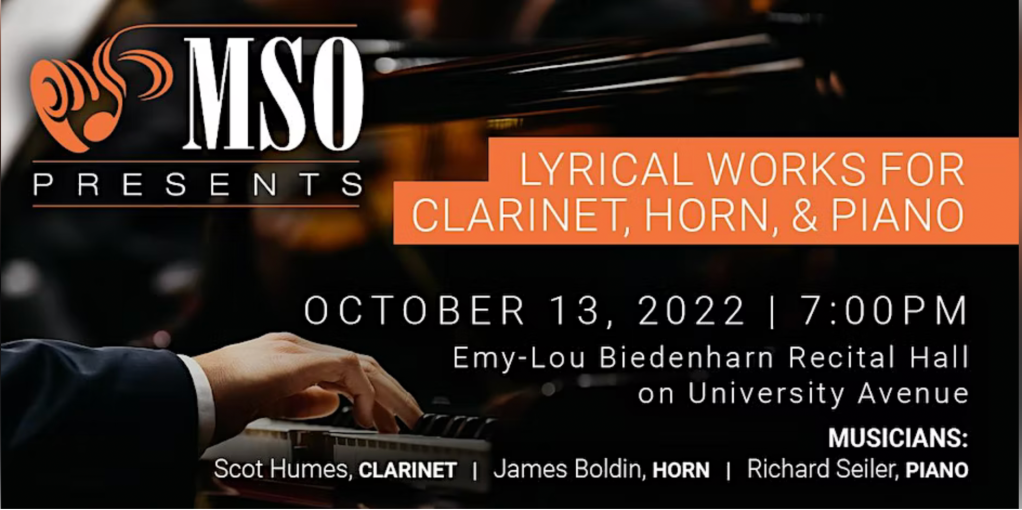Here are some videos from a recital a few months ago, “Lyrical Works for Clarinet, Horn, and Piano” on October 13 on the ULM campus. Presented as part of our local orchestra’s chamber music series, this was a fun concert to program and put together with my colleagues Scot Humes on clarinet and Richard Seiler on piano.

Carl Reinecke, Trio in B flat-major Op. 274 for Clarinet, Horn, and Piano
Gina Gillie, Three Paintings for Clarinet, Horn, and Piano *World Premiere
George Rochberg, Trio for B-flat Clarinet, F Horn, and Piano
The only work I’d performed before was the Rochberg, way back in 2006 on a doctoral recital at the University of Wisconsin-Madison. Of particular interest is the world premiere of Gina Gillie’s trio, a work we commissioned. If you don’t know any of Gina’s music I highly recommend you check it out! Program notes for these works are included after each video. I hope you enjoy listening, and best wishes for peaceful conclusion to 2022 and a prosperous beginning to 2023!
Trio in B flat-major Op. 274 for Clarinet, Horn, and Piano, Carl Reinecke (1824-1910)
German composer, pianist, conductor, and music teacher Carl Reinecke directed the Leipzig Gewandhaus Orchestra, taught at the Leipzig Conservatory, and composed prolifically in a variety of genres. Edvard Grieg, Leoš Janáček, Isaac Albéniz, and Max Bruch were among his many successful students. Reinecke began his musical training on the violin, but soon turned his attention to the piano, and embarked on numerous concert tours across Europe. He held positions in Cologne and Copenhagen before settling in Leipzig in 1860 for the remainder of his career. Regarded as an extremely versatile and influential musician, Reinecke composed numerous operas, symphonies, concertos, and chamber works, including the charming Trio, Op. 274, which dates from around 1905. Having retired from his teaching position at the Leipzig Conservatory in 1902, Reinecke devoted his final years to composition. This four-movement work draws upon Reinecke’s lifetime of musical experiences, and is reminiscent of Mendelssohn, Brahms, and Schumann, all of whom he knew personally.
This three-movement work is a programmatic piece that, while it is not based on any specific paintings, is meant to evoke images of what could be a classic painting in the mind of the listener. Each movement is set in a particularly distinct regional setting, the locations of which were chosen for stylistic contrast. The first movement, “Highland Castle,” sets the scene of an old Scottish castle standing stoically amongst a grey landscape. The castle is no longer occupied, but observers can imagine the revelry and energetic Celtic music that might have once animated the scene. The horn begins by playing into a piano with a depressed damper pedal, thus causing sympathetic vibrations to sound like an echo that can be heard across the landscape. The melody is set in the Dorian mode, a common tonality for Celtic folk tunes. While the melody is original, it is meant to sound like it could be an old tune from centuries ago. Recollections of festivities past are conjured as the tempo picks up into a dance with a lopsided meter (6+4/8).“Lavender Fields” evokes images of pastoral fields in France where the purple flowers stretch down puffy rows and the pace of life feels slower. Set in the style of French impressionist music, and specifically influenced by Fernande Decruck, this movement encourages the listener to bask in the wash of lovely sound and lush harmonies.“Conneaut Rag” is influenced by a very American style of music from the early 1900s –Ragtime. The movement was written while the composer was visiting her in-laws in Conneaut, Ohio. The feeling of Mid-western Americana inspired the style of this movement. Again, the melody is original, but it draws on the rich history of the tradition of ragtime in order to give the listener a sense that it could possibly be from a bygone era.
Trio for B-flat Clarinet, F Horn, and Piano George Rochberg (1918-2005)
After serving as Director of Publications for the Theodore Presser Company, American-born composer George Rochberg taught at the Curtis Institute and the University of Pennsylvania. He also held appointments as a guest composer at numerous universities and contemporary music festivals throughout the United States. His works for stage, orchestra, chamber ensemble, voice, and solo instruments earned him two Guggenheim fellowships, two grants from the National Endowment for the Arts, and several commissions from major American symphony orchestras, including the Pittsburgh Symphony and the New York Philharmonic. A well-known author on contemporary music, Rochberg’s writings were published in 1984 as The Aesthetics of Survival: A Composer’s View of Twentieth-Century Music. Initially a serialist composer, Rochberg rejected serialism in favor of a combination of chromatic and tonal elements after the death of his son. His Trio, originally published in 1948 and revised in 1980, is largely tonal and makes use of traditional sonata form elements in the first and third movements. The first movement begins with an extended horn cadenza, and presents all of the thematic material for the movement. A lively allegro follows this opening, with cadenzas for both piano and clarinet coming at various points in the movement. A slower second movement explores the color potentials of the horn, clarinet, and piano combination, gradually growing in intensity and tempo. Short cadenzas again feature each of the instruments, and the movement closes in much the same way as it began. The finale opens with alternating adagio and allegro sections, but eventually settles into a jaunty triple meter dance. As in the first movement, Rochberg demonstrates his skill at manipulating motivic material, treating motives in inversion and fugally. After reaching an almost unbearable level of tension, the Trio drives to its conclusion in a suddenly faster coda.